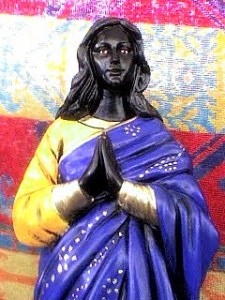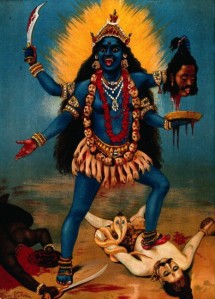Fox-Frazier Foley, writer and curator of The Infoxicated Corner of The The Poetry Blog, solicited an essay about Romani poetics and language, and immediately I knew I would write about Luminiţa Mihai Cioabă’s poem “The Apparition of Choxani,” from the anthology The Roads of The Roma: a PEN Anthology of Gypsy Writers. Fox has mixed Romani heritage too, so the project felt like a gorgeous act of unity and cultural collaboration.
For me to better understand “The Apparition of Choxani,” and write what became my article, The Magic Word:
‘Gypsy’ Witchcraft, Love, and Breaking Tradition in Luminiţa Mihai Cioabă’s Poem “The Apparition of Choxani,” I had to look at my Romani family’s history as well as our traditions—not those that endured, but rather those that were extinguished.

With a headband that my lovely Romani friend, writer Norma Szokolyai, gave me when we taught in France together on the CWW Yoga & Writing Retreat
My entire Romani identity is invested in my grandmother and what she taught me, and her identity springs from what her family could pass on to her while simultaneously obscuring their ethnicity and shedding their culture, attempting to avoid the gas chambers or a bullet in a ditch. They had a unique opportunity to do this, namely that some of the Romani family had already married gadjé and assimilated for love, and my beautiful and resourceful great-grandmother decided to re-marry a cruel-but-useful gadjo (non-Roma) and bring her three children with her to his farm in the countryside. There are whispers that her papers were forged and documents were signed by Hitler, but the details were lost a long time ago. This saved our line but left holes in our Romanipen (The Romani Way)—we lost parts of our Roma soul. I never learned Rromanès, because my grandmother wasn’t allowed to speak it—how could they explain to the suspicious Nazi officers who burst-in from time to time why their children spoke Gypsy-tongue? Most Romani families affected by the Holocaust did not break and bury their traditions. Fate tossed my great-grandmother a bone and she took it, but most Roma in WWII Europe knew that they could not assimilate and would not be allowed to. They spoke Rromanès and Romani women wore dikhle (traditional head coverings), even in the concentration camps. In the camps, there are accounts of Roma singing traditional songs and even dancing to keep their spirits and their dignity. What else is there to do in the face of utter hatred and persecution but dance? Recently, a Belgian village hired a DJ tried to try to (illegally) oust Roma from their camps with loud music, and the Roma danced then too.
My grandmother taught me our family trades, dancing and drabaripé (fortune telling, and healing magic), and although I didn’t learn about Choxani until I began researching my more about my cultural heritage as a young woman, she taught me about a different kind of witch— the drabarni, or healer or adviser. Usually the drabarni is a woman in the Romani community who uses prayer, amulets, herbs, and energy work to heal physical, emotional, and spiritual illness. Some of these practices survived in my family because far down the line there was a drabarni in my grandmother’s family. Romani magic is quite real within the culture, but it looks nothing like the “Gypsy Witchcraft” books you can get at B&N. Even though our family assimilated and we lost so much, even though I went to school with gadjé children where I didn’t learn anything about the history of my people, not even the fact that Americans enslaved Roma alongside African Americans in the Old South, I was still different. I was still stoned till I bled on the playground after I leaked the truth about my family roots when I was six years old and too proud of my grandmother for my own good, despite her many warnings to stay quiet. I was still given detention by my fifth grade teacher for being a “Gypsy witch.” I started wearing the epithet like a mantle. I proudly practiced my family trades when I was a teen, through college, and whenever I was in a tight spot. But it was still nothing like the fantasy Gypsies in story books– it was real, gritty, and sometimes heartbreaking. It was an identity that I claimed with such mixed feelings that, for years at a time, I would refuse to crack open my deck of cards because I couldn’t be a Gypsy freak-show for one more day. And other times, I felt like I was making my ancestors proud, that I was my grandmother’s blood, and I was grateful for my beautiful and complex culture.
In short, it matters when the word “Gypsy” is appropriated and redefined by outsiders. It’s our heritage, it’s our genocide, it’s our right to reclaim the ethnic slur used against us. If we are witches, it is because we have not been understood by outsiders–we are not magical, but we have a powerful culture. So be it.













